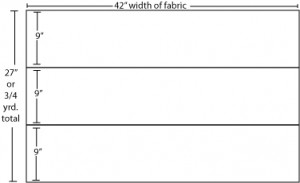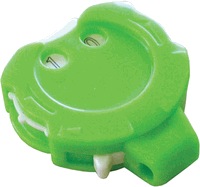Ruffles can be added to almost anything: skirt or nightgown hems, decorate edges to a pillow, adding trim to a baby blanket, making a plain tee shirt into something extraordinary, the ideas are endless. Listed here you will find directions and tips on how I make my own ruffles or change up a ruffle within a pattern I already have.
CALCULATING THE SIZE
First, you need to determine the circumference (the distance around your item) of where you want to add the ruffle. Next, decide how much gathering you want from your ruffle; do you want a very full, fluffy ruffle or a more subdued, soft style ruffle. A very full, fluffy ruffle would most likely be about 2.5 times your circumference, a little less full calculate 2 times your circumference and, even a less gathered ruffle would be 1.5 times your circumference.
Now figure how wide you want your finished ruffle. You will double that width and add one inch for your seam (1/2″ for each side). The reason I like to double the width of the finished ruffle is you will not have to hem your ruffle and it gives it a little more stability to help hold its shape and you have such a nice clean and professional look when completed. This technique is called a double-layered ruffle.
For example, your circumference is 40 inches and you want your ruffle to be 2.5 times the circumference and finished at 4 inches wide. Your ungathered, cut ruffle will measure 100 inches (40 x 2.5 = 100) by 9 inches.
Your yardage requirements based on a 42″ wide fabric would be 3 widths with each width measuring 9″ for a total of 3/4 yard of fabric needed to make that size ruffle. Don’t forget to add a 1/2″ seam allowance to each width for sewing them together to make your 100 inch ungathered, cut ruffle.
PREPARING YOUR RUFFLE
Using the above example, cut two (2) strips 42″ by 9″ and cut one (1) strip 19″ by 9″, this includes your 1/2″ seam allowance on each end of each strip. Now sew these three (3) strips together to form one long strip of fabric.
Take your two (2) short ends, right sides together and sew these in a 1/2″ seam allowance making a circle of fabric. Press open all your seams. Now fold your fabric circle in half wrong sides together and press.
At this point, you can either place some pins around to hold your fold in place or baste a 1/4″ seam around your fabric circle to hold it together.
SEWING YOUR GATHERS
This is my favorite way to sew/baste my threads for a project requiring me to gather the fabric. I use my regular sewing machine thread which matches the fabric and I also use a heavy, duty sewing thread. You can use Coats and Clarks Dual Duty XP Heavy thread, which is a thicker, stronger thread and will not break when you begin your gathering.
Now, lay the heavy thread close to the raw edge of your fabric circle, leaving about a 4″ tail, and begin to baste over your heavy thread with a zigzag stitch making sure not to catch the heavy thread in your machine zigzag stitching. Set your machine for a longer and wider zigzag stitch but  make sure that the stitching size stays within your 1/2″ seam allowance.
make sure that the stitching size stays within your 1/2″ seam allowance.
Zigzag over your heavy thread around your entire circle, again leaving about a 4″ tail of your heavy thread, cut your regular threads close to the fabric and remove your fabric circle from the sewing machine. This method of making gathering stitches can be used for almost any project that requires you to have to gather something.
Hang in there, you are almost ready to gather and sew your completed ruffle.
MARKING, PINNING AND SEWING RUFFLE TO GARMENT
At this step, it is important to divide both the ruffle and your garment into quarters. Pin/match your ruffle markings to the garment markings with right sides together. Now you can begin to gather your ruffle by pulling on those 4″ heavy thread tails and pinning it in place all the way around. Having your ruffle and garment marked into quarters will insure that your ruffle is gathered evenly around.
Once you have it pinned, you can begin sewing the right sides together in a 1/2″ seam allowance. Depending upon your project and the weight of your materials, you might want to reinforce your seam by sewing around the ruffle a second time.
You have a couple of options next, you can finish your raw edge by serging it, if you own a serger machine or do an overlock stitch to finish your edge, if you have that stitch available on your machine. If you don’t have either of the above stitch capabilities, you can finish your edge with a close zigzag stitch by shortening and narrowing the zigzag stitch on your machine.
Depending upon your project, you can now lightly press the ruffle down and the seam up towards the garment.
I make double-layered ruffles all the time no matter what the pattern directions call for. The only time I would use a single-layered ruffle would probably be when using a very thick/heavy fabric say for drapery treatments. Remember too, you can cut your fabric strips on the bias for more give or stretch, which will help the ruffle lay nicely especially along a curvy neckline. Continue to sew your strips following the directions above.
You can lengthen a skirt, top or pants by adding a coordinating/contrasting ruffle to the garment, a great way to expand the life of clothing for children. If wanting to add a ruffle to a pair of jeans, because of the thickness of the jeans, I would sew the raw edge of the ruffle to the wrong side of the jean. Then you can take a cute decorative ribbon and sew that over the stitching line or add funky/colorful buttons along the stitching line. Always adding those little extra touches, definitely makes the garment your own!!
HAPPY CREATING!!
Disclaimer: This post contains affiliate links – “small commission earned”










